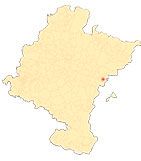Javier, a castle for a saint
Museum
After the restoration of 2005, the north wing of the castle, spread over three floors, has been dedicated to a museum to present the figure of St. Francis Xavier, his missionary activity, the influence of his person over the centuries and the cult he has generated.
The tour begins in the basement floor, where the life of the saint is recalled through twelve dioramas by José López Furió (1930-2000), a Valencian living in Navarra, a neo-figurative sculptor specialized in religious imagery and author of numerous sculptures of St. Francis Xavier and the Christ of Javier.
A ramp, which houses the painting "El divino impaciente" by Elías Salaberría (1883-1952), leads to the second floor, where special mention is made of María del Carmen Azlor de Aragón (1846-1905) at accredited specialization , XV Duchess of Villahermosa and owner of Javier, who between 1891 and 1904 financed and promoted the first restoration of the castle and the construction of the basilica and the high school (today a spirituality center), in addition to donating the entire complex to the Society of Jesus. The work realized can be verified by contrasting the state of the castle in the watercolors of 1889, in the plans of the architect Goicoechea or in the model that reproduces his status around 1500. To his munificence is also due the pictorial collection exhibited on this floor, Renaissance and Baroque, with religious themes, both Jesuit and referring to Christ, the Virgin and various saints. A collection of medals testifies to the cult of the saint for three centuries.
The second floor commemorates the missionary activity of St. Francis Xavier and offers a sample of the art generated by the devotion to the saint. Among the objects originating in India, a 17th century Luso-Indian ivory depicting the Good Shepherd stands out. Six 19th century Japanese kakemonos show their evangelizing activity in the Empire of the Rising Sun, especially their landing and dialogue on religious matters in Yamaguchi. They are completed with a banner with the effigy of Xavier writing his famous letters. Among the pictorial collection are the six large canvases that decorated the chapel erected in the New Palace, made in 1692 by the Flemish painter Godefroy de Maes (1649-1700) and his workshop. Maes excelled as a painter of religious scenes, allegorical subjects and portraits. A disciple of his father, from 1672 he worked as a studio master and in 1682 he was appointed director of the Antwerp Academy. The most outstanding canvas of the set, signed by Maes, with a complex and elaborate composition influenced by Rubens, represents St. Francis Xavier preaching in India and achieving the conversion of people of all subject and condition. It also highlights the canvas dedicated to the cessation of the plague in Manar, which follows the model of the Italian Ciro Ferri and achieves an excellent composition with abundant lines and diagonals, rich in effects.












